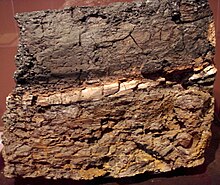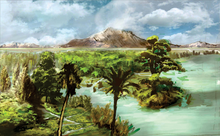
Back Paleoseen Afrikaans العصر الباليوسيني Arabic Paleocenu AST Paleosen Azerbaijani Палеацэн Byelorussian Палеоцен Bulgarian Paleosen Breton Paleocen BS Paleocè Catalan Paleocén Czech



The Palaeocene is the first geological epoch in the Palaeogene. It was from 66 to 56 million years ago. It started after the end of the Cretaceous, and it was followed by the Eocene epoch.
The word "Palaeocene" may be spelled "Paleocene" quite correctly. It is just an alternative spelling.
The Palaeocene began and ended with an extinction event, each of quite a different character. The epoch began with the K/T extinction event, caused by a combination of a meteorite strike (Chicxulub crater) and a huge volcanic flood basalt eruption. The eruption produced the Deccan Traps in what is now India. This would have caused the extinction of many groups.
The epoch ended with the Palaeocene–Eocene Thermal Maximum, a deep ocean anoxic event (DOAE). This means that the ocean depths were lacking oxygen, so no higher forms of life could survive there. This produced a mass extinction of between 35–50% of deep water forms such as benthic foraminifera. At the same time there was a major change of mammalian types on land.